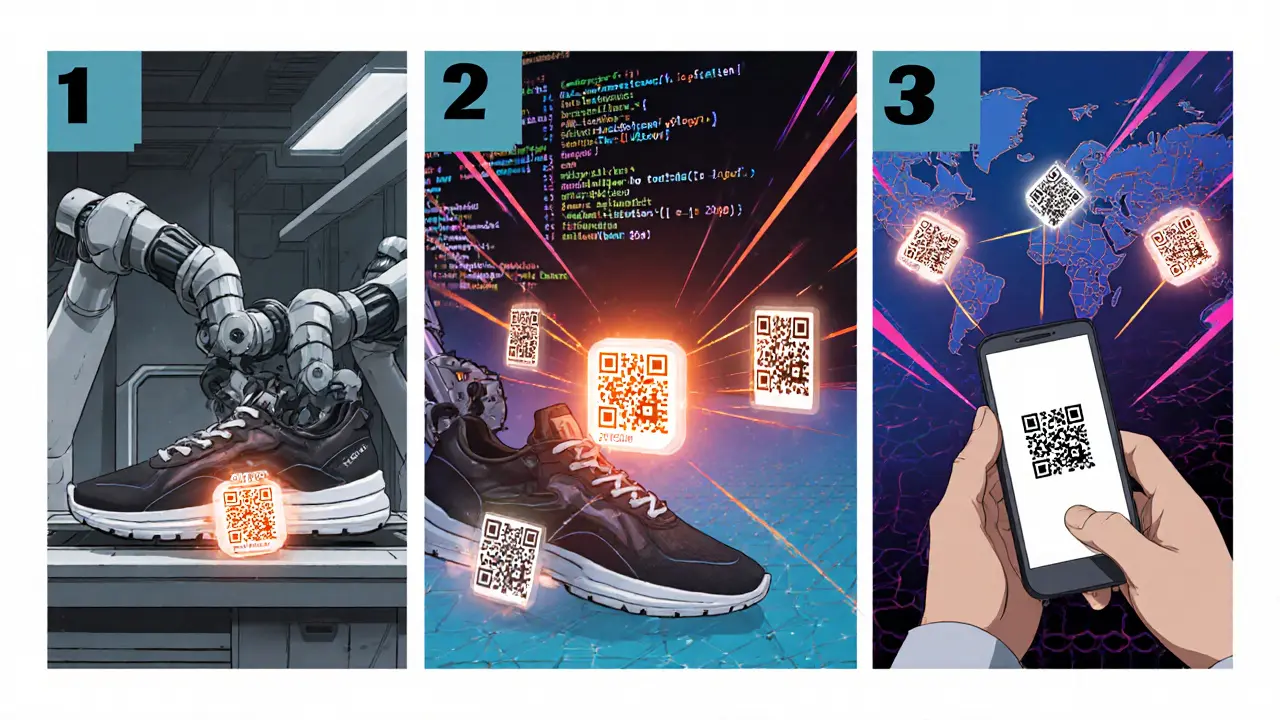NFT Anti-Counterfeiting Feature Comparison
NFT-Based Features
- Immutability ✓
- Traceability ✓
- Uniqueness ✓
- Smart Contracts ✓
- Interoperability ✓
Traditional Methods
- Holograms ✗
- Serial Numbers ✗
- RFID Tags ✗
- Paper Certificates ✗
- Physical Barriers ✗
| Feature | NFT-Based | Traditional |
|---|---|---|
| Immutability | Permanent on-chain record | Paper certificates can be altered |
| Traceability | Full transaction history visible | Often siloed, limited visibility |
| Cost of Verification | Automated, low marginal cost | Manual checks, higher labor cost |
| Scalability | Can handle millions of tokens | Physical labels become expensive at scale |
| Physical Protection | Relies on external markers | Intrinsic (e.g., hologram, RFID) |
-
Tamper-proof Security: Decentralized ledger makes it virtually impossible to rewrite ownership history.
-
Transparent Verification: Anyone can query the blockchain to see full provenance.
-
Cost-Saving Automation: Smart contracts automate verification without manual paperwork.
When it comes to fighting fake products, NFT anti-counterfeiting is a blockchain‑based method that uses digital certificates to prove a item's authenticity. The approach offers an immutable, traceable record that can be checked by anyone, turning the age‑old counterfeit problem into a verifiable digital handshake.
What the term really means
Non‑Fungible Token (NFT) is a unique cryptographic token stored on a blockchain. Unlike a regular cryptocurrency, each NFT carries distinct metadata that can represent ownership of a physical or digital asset. When an NFT is linked to a product, it becomes a digital certificate that lives forever on the ledger.
Core technical features that make NFTs useful for authentication
- Immutability - Once the NFT metadata is written, the blockchain prevents any alteration, guaranteeing the record stays unchanged.
- Traceability - Every transfer of the token is logged, creating a continuous chain of custody that can be audited at any time.
- Uniqueness - Cryptographic signatures ensure each NFT is one‑of‑a‑kind; duplication is mathematically impossible.
- Smart contracts - Self‑executing code (see smart contract) can enforce verification rules automatically, such as rejecting transfers to unverified wallets.
- Interoperability - NFTs follow open standards (e.g., ERC‑721, ERC‑1155), allowing them to be read by many platforms and devices.
Why NFTs beat traditional anti‑counterfeiting methods
Traditional solutions-holograms, serial numbers, RFID tags-rely on physical barriers that can be copied or removed. NFTs add three layers of protection:
- **Tamper‑proof security**: The decentralized ledger makes it virtually impossible for a counterfeit to rewrite the ownership history.
- **Transparent verification**: Anyone with an internet connection can query the blockchain to see the full provenance, eliminating closed‑door checks.
- **Cost‑saving automation**: Smart contracts handle verification without manual paperwork, cutting down on labor and middle‑man fees.
For high‑value markets like luxury goods or pharmaceuticals, the added confidence can translate into higher resale prices and reduced recall risks.

Limitations - why a hybrid approach is still needed
NFTs excel at proving digital ownership, but they cannot stop a physical item from being copied. Experts point out that a fake product without a genuine NFT will simply lack a valid digital passport, yet a counterfeiter could still produce a replica and attach a forged NFT on a weak platform. The solution is to pair NFTs with physical authentication methods-such as fingerprinting, micro‑printing, or invisible ink-that create a unique surface signature linked to the token. This blend ensures both the tangible object and its digital record are protected.
Step‑by‑step implementation guide
- Choose a blockchain network (e.g., Ethereum, Polygon, Flow) that matches your speed, cost, and environmental goals.
- Define the data model for your product passport: serial number, manufacturing date, cryptographic hash of physical security features.
- Develop a smart contract that mints an NFT for each unit, stores the metadata, and enforces transfer rules.
- Integrate the minting process with your supply‑chain ERP so that a token is created the moment the item leaves the factory.
- Attach a physical marker (e.g., QR code, NFC tag, laser‑etched serial) that can be scanned to retrieve the NFT ID.
- Deploy a consumer‑facing verification app or web portal where customers can scan the marker and instantly see the blockchain record.
- Train internal teams and partners on how to handle token transfers, revocations, and updates.
- Monitor the ledger for suspicious activity and set up automated alerts via the smart contract.
The whole process typically takes 3-6 months for a digital‑only rollout and 6-12 months when physical security layers are added.
Comparison: NFT anti‑counterfeiting vs. traditional methods
| Feature | NFT‑Based | Traditional |
|---|---|---|
| Immutability | Permanent on‑chain record | Paper certificates can be altered |
| Traceability | Full transaction history visible | Often siloed, limited visibility |
| Cost of verification | Automated, low marginal cost | Manual checks, higher labor cost |
| Scalability | Can handle millions of tokens | Physical labels become expensive at scale |
| Physical protection | Relies on external markers | Intrinsic (e.g., hologram, RFID) |

Industry use cases that are already live
- Luxury fashion: Brands mint NFTs that act as product passports; owners can scan a hidden QR code inside the label to view provenance from runway to resale.
- Pharmaceuticals: A leading drug manufacturer links each batch to an NFT, enabling pharmacists to verify authenticity before dispensing.
- Automotive: Car makers issue NFTs that record VIN, service history, and ownership transfers, simplifying resale and warranty claims.
- Real estate: Property deeds are tokenized, allowing buyers to confirm title history without costly title searches.
- Government documents: Some municipalities pilot NFT‑based birth certificates to curb fraudulent issuance.
Future outlook - standards, dynamic NFTs, and regulatory hooks
Experts expect a wave of industry standards that define fields for product passports, making cross‑chain verification possible. Dynamic NFTs-tokens whose metadata can evolve-will let manufacturers update safety notices or recall status without re‑minting. At the same time, regulators are drafting guidelines on data privacy for on‑chain records, especially in the healthcare sector.
The biggest hurdle remains education: firms must train supply‑chain managers, IT staff, and end‑users to read and trust blockchain proof. Early adopters who build robust hybrid systems (digital + physical) will likely lock in brand trust and enjoy lower insurance premiums.
Frequently Asked Questions
How does an NFT prove a physical product’s authenticity?
The NFT stores a cryptographic hash of a physical security feature (like a laser‑etched serial). When a consumer scans the marker, the app looks up the hash on the blockchain and confirms it matches the recorded value, proving the item is genuine.
Can NFTs be hacked or duplicated?
Because the token lives on a decentralized ledger, altering its data would require controlling >50% of the network’s computing power-a feat that is practically impossible for large public blockchains. Duplication is prevented by the unique token ID and cryptographic signature.
What if the physical marker (QR code, NFC) gets damaged?
Hybrid systems usually embed the marker in multiple locations (inside stitching, label, and an invisible ink tag). If one fails, another can still be scanned. Some solutions also store the NFT ID in a secure database that can be retrieved using the product’s serial number.
Is the technology expensive for small brands?
Public blockchains charge a transaction fee (gas). For low‑volume runs, sidechains or Layer‑2 solutions like Polygon can keep costs under a few cents per token, making it viable even for boutique producers.
Will governments require NFT passports for regulated goods?
Some jurisdictions are already drafting legislation that mandates blockchain traceability for pharmaceuticals and high‑value electronics. While adoption timelines vary, the trend suggests that compliance will increasingly rely on NFT‑backed records.







Cathy Ruff
March 20, 2025 AT 07:54NFTs are hype but the tech actually locks down product provenance like a digital vault they’re immutable and traceable stop fakes in their tracks
Katherine Sparks
March 27, 2025 AT 04:54Thank you for sharing this comprehensive guide 😊. While the information is thorough, I noticed a few minor typographical errors that could be polished for clarity. Nonetheless, the structured approach to integrating blockchain with physical markers is commendable.
Jenise Williams-Green
April 3, 2025 AT 01:54It is profoundly disturbing how quickly the market latches onto every shiny new technology without scrutinizing its ethical ramifications; one must question whether we are truly safeguarding consumers or merely creating another layer of digital exclusivity that favors the privileged.
Kortney Williams
April 9, 2025 AT 22:54From a philosophical standpoint, the merger of physical authenticity and digital verification provokes an intriguing dialogue about the nature of trust in modern commerce; the transparency offered by immutable ledgers could foster a renewed sense of consumer confidence.
Laurie Kathiari
April 16, 2025 AT 19:54While I applaud the ambition behind NFT passports, the reality remains that a slick token cannot shield a product from a crafty forger armed with counterfeit markers; without robust physical safeguards, the blockchain illusion is merely a polished veneer.
Promise Usoh
April 23, 2025 AT 16:54In my view the choice of blockchain platform is paramount; a network with low transaction fees and high throughput such as Polygon or Flow may alleviate cost concerns whilst maintaining the decentralised integrity required for mass adoption.
Taylor Gibbs
April 30, 2025 AT 13:54Hey folks, just a heads up – when you’re linking the QR code to the token, make sure the user experience is smooth; a clumsy app can turn a cool tech feature into a frustrating barrier for everyday shoppers.
Amy Harrison
May 7, 2025 AT 10:54Love the idea of scanning a QR to see a product’s whole story 📱✨ – it turns buying into an adventure and gives buyers confidence that they’re getting the real deal!
Miranda Co
May 14, 2025 AT 07:54But if the QR code cracks or gets scratched, the whole system falls apart and the buyer is left with nothing but a broken promise.
Natalie Rawley
May 21, 2025 AT 04:54Honestly, this whole NFT anti‑counterfeit hype feels like the tech industry’s latest fad, a glittering distraction from the fact that most consumers will never even understand what a token is, let alone care about its provenance.
Scott McReynolds
May 28, 2025 AT 01:54The integration of NFTs into supply chain verification represents a paradigm shift that extends far beyond mere novelty. First, the immutable nature of blockchain records ensures that once a product’s digital passport is minted, its provenance cannot be retroactively altered without consensus from the network. Second, traceability becomes a transparent ledger where every handoff-from manufacturer to distributor to retailer-is logged in real time, offering unprecedented visibility. Third, the cost of verification is dramatically reduced because smart contracts automate authenticity checks without the need for labor‑intensive manual inspections. Fourth, scalability is practically limitless; a single blockchain can handle millions of tokens, making it suitable for both luxury goods and mass‑market items. Fifth, the synergy between physical markers like QR codes or NFC tags and their digital counterparts creates a dual‑layer defense against counterfeiting. Sixth, consumer trust is bolstered as shoppers can instantly verify an item’s origin with a simple scan, turning skepticism into confidence. Seventh, manufacturers gain valuable data analytics from token interactions, enabling them to monitor product performance and recall efficiency. Eighth, regulatory compliance becomes more straightforward as immutable audit trails satisfy many governmental requirements for traceability. Ninth, the environmental impact can be mitigated by selecting energy‑efficient blockchains or layer‑2 solutions that minimize carbon footprints. Tenth, the evolving standards-such as ERC‑721 and ERC‑1155-ensure interoperability across platforms, preventing vendor lock‑in. Eleventh, dynamic NFTs allow manufacturers to update metadata, such as safety notices or warranty extensions, without re‑minting new tokens. Twelfth, the legal enforceability of smart contracts provides a framework for handling disputes over ownership or authenticity. Thirteenth, the community aspect of decentralized networks fosters collaborative security, where multiple stakeholders monitor for anomalies. Fourteenth, the adoption curve, while still early, is accelerating as more brands publish success stories, encouraging peer adoption. Finally, the true power of NFT anti‑counterfeit solutions lies in their ability to blend digital assurance with tangible security, creating a holistic ecosystem that safeguards both brand reputation and consumer welfare.
John Corey Turner
June 3, 2025 AT 22:54Indeed, the data analytics derived from token interactions can reveal patterns that were previously invisible, allowing brands to proactively address supply‑chain vulnerabilities before they manifest as costly recalls.
Kimberly Kempken
June 10, 2025 AT 19:54Let’s not be fooled into thinking that blockchain is a silver bullet; the technology is still riddled with scalability bottlenecks and privacy concerns that could undermine the very trust it promises.
Eva Lee
June 17, 2025 AT 16:54Moreover, the absence of standardized ontology for product metadata creates semantic dissonance across disparate ledgers, hampering cross‑chain interoperability and necessitating a meta‑protocol governance layer.
Ciaran Byrne
June 24, 2025 AT 13:54Choosing a low‑fee Layer‑2 solution can keep costs under a few cents per token.
Adarsh Menon
July 1, 2025 AT 10:54Oh great, another “game‑changing” tech that will totally solve all our problems while we waste hours figuring out how to scan a QR on a bottle.
Shaian Rawlins
July 8, 2025 AT 07:54I appreciate the enthusiasm surrounding NFT passports, yet I remain cautiously optimistic because real‑world adoption hinges on accessibility and education. If consumers are required to download a dedicated app, keep their phones charged, and understand blockchain basics, many will simply opt out. A hybrid approach that pairs invisible ink or micro‑printing with a simple QR code could bridge this gap, offering a seamless experience. Manufacturers should invest in clear, multilingual instructions that guide users step‑by‑step through verification. Additionally, partnerships with retailers to provide in‑store verification kiosks can alleviate the burden on end‑users. By lowering the technical barrier, the technology stands a better chance of becoming a mainstream trust instrument rather than a niche novelty. Ultimately, the goal should be to make authenticity checks as effortless as scanning a barcode at checkout. When the process feels natural, adoption will follow organically.
Rob Watts
July 15, 2025 AT 04:54While I agree on the need for in‑store kiosks, they must be maintained securely to prevent tampering that could reintroduce counterfeit risks.
Bhagwat Sen
July 22, 2025 AT 01:54Speaking of security, integrating biometric verification with NFT scans could add an extra layer, ensuring that only authorized personnel can validate high‑value items.
mukesh chy
July 28, 2025 AT 22:54Sure, because adding face‑recognition to a blockchain token won’t just complicate privacy laws but will also make the whole system a nightmare for regulators.
Jim Griffiths
August 4, 2025 AT 19:54For developers, using ERC‑1155 allows batch minting, which reduces gas costs when deploying large product lines.
Marc Addington
August 11, 2025 AT 16:54That’s precisely why some companies favor private permissioned chains to keep costs low and control who can read the data.
Amal Al.
August 18, 2025 AT 13:54Dear colleagues, please note that excessive on‑chain data can inflate storage costs; therefore, it is advisable to store only essential hashes on the ledger and keep supplementary details off‑chain in a secure database. Thank you.
Alex Gatti
August 25, 2025 AT 10:54Absolutely, leveraging off‑chain storage with IPFS can maintain data integrity while keeping on‑chain footprints minimal.
stephanie lauman
September 1, 2025 AT 07:54It is imperative to recognize that the purported security of NFTs is often overstated; the reality is that malicious actors can still orchestrate sophisticated phishing campaigns to deceive users into revealing private keys, thereby compromising the very authenticity the system purports to guarantee 😊.